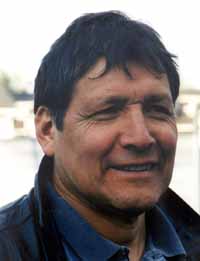William G. Demmert, Jr. on Improving Academic Performance Among Native American Students
As part of the Institute on Urban and Minority Education's Mellon Visiting Minority Scholars program, William G. Demmert, Jr. spoke at Teachers College on "Improving Academic Performance Among Native American Students: A review and analysis of the literature." Through a grant from the Mellon foundation, the visiting scholars program brings up to six prominent minority scholars to Teachers College to give informal seminars and spend several days on campus to dialogue with faculty and students.
Demmert, a Native-American, has been a professor at Western Washington University's Woodring College of Education since 1992. Previously, he was the Irvine Scholar and Visiting Professor at Stanford University; Commissioner of Education for the State of Alaska; Director of Indian Education Programs for the U.S. Department of the Interior; and Deputy Commissioner in the U.S. Office of Education, Health, and Welfare. His research and publications focus on finding successful ways to educate American Indians, native Alaskans, and Hawaiians.
He began by explaining he would actually be giving two presentations. The first one was a review and analysis of the literature on the academic achievement of Native Americans. The second part was a look at the history of the peopling of Alaska through pictographs and petroglyphs.
"One of the problems with education in the United States, when you talk about the Native American community, is that historically you start too late. I wanted to start with my grandmother's people when they first entered Alaska. Because one of the problems we do have in the education of native peoples is that the perspective presented in school is not always consistent with the perspective that we've grown up with."
In his presentation, Demmert interspersed slides of petroglyphs and pictographs from south-eastern Alaska, and explained the significance of the images and their connection to legends he heard as a child.
The presentation focused on two studies: a Rand study that reviewed the research literature on Native American education, and a project from the Northwest Regional Educational Laboratory on culturally based education (CBEs). Part of the Rand study was an evaluation of the feasibility of doing a national study of Native American education, specifically CBEs.
He gave an overview of the legislation that gave the federal government control over Indian education, created the Bureau of Indian Affairs (BIA), and gave American citizenship to Native Americans. The Citizenship Act of 1924 formally accepted all U.S. born Native Americans as U.S. citizens. Since Demmert's time in the Bureau of Indian Affairs, the number of students in BIA and tribal schools has dropped as more and more Indian students moved into the public schools.
The Rand study included an annotated bibliography of all the research they found on the education of Native Americans. The first part of that report was published on ERIC, and can be found at www.ael.org/eric/demmert.pdf. The second piece of the report looked at the National Assessment of Educational Progress (NAEP) data on reading, mathematics, and geography. While Native students have improved slightly in reading and mathematics there continues to be a gap in achievement between them and white students. Interestingly, however, Native students score as well in geography as other groups. The study found that native language and cultural programs improved students' motivation, sense of identity and self, positive attitudes, and academic performance. The study also showed the importance of early childhood experiences, quality teaching, and family and community support, which is true of education in general. Curriculum that was congruent with the community served also had positive effects.
Demmert also mentioned his work with the ministries of education of the Circum-Polar North, which includes all the nations that touch the Arctic Circle. The group includes Alaska, northern Canada, Greenland, Russia, Norway, Sweden, and Finland. The focus of the group is the education of native peoples. Demmert found that other native peoples of the Circum-Polar North share many of the issues faced by Native Americans.
The Rand study identified six critical elements that characterized culturally based education. "Recognition and use of Native American languages, pedagogy that addresses cultural characteristics and adult-child interactions, pedagogy in which teaching strategies are congruent with traditional culture and ways of knowing and learning, curriculum that is based on traditional culture and that recognizes the importance of Native spirituality, strong community participation in educating children and in planning the operation of school activity including parents, elders, and other community resources; knowledge and use of the social and political mores of the community."
Demmert gave an overview of the research in the Rand study. Very few studies had an experimental design, and most lacked independent evaluations. His recommendations for a possible national study included, "coordinate a broad-based research effort, target student learning, use valid measurements of student learning?design research that establishes adequate basis for comparison?link the design of treatment programs to established theory and previous research."
During a question and answer session following his talk, Demmert spoke of the efforts among Native Americans to preserve Native languages. "Of course the federal government, when they first took over the responsibility for educating American Indians, Native Alaskans, and eventually the Native Hawaiians, was to move them away from the language and cultural base that they grew up in as quickly as possible," said Demmert. "Of course they told my parents that learning more than one language would be harmful to their academic pursuits, to their cognitive development. Of course we know that's wrong."
He noted that many countries that score well on international tests are highly multilingual; he believes that multilingualism may have positive effects on cognitive development. This is of interest to Native Americans striving to preserve their languages.
Published Tuesday, Jun. 17, 2003
